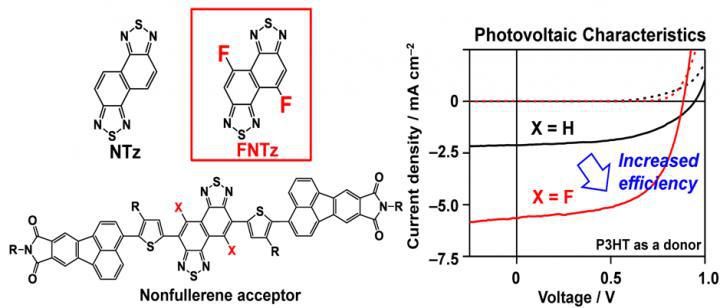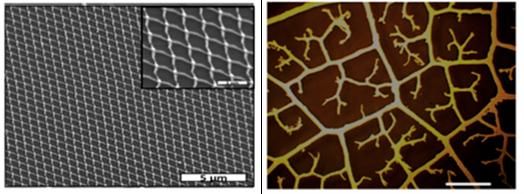Controlling organic semiconductor band gaps by electron-acceptor fluorination
A fluorinated electron-acceptor unit for high performance organic semiconductors
Organic semiconductor materials have the potential to be used in innovative applications such as transparent and flexible devices, and their low cost makes their potential use particularly attractive. The properties of organic semiconductor materials can be tuned by controlling their structure at the molecular level through parts of the structure known as electron-accepting units. A group of researchers centered at Osaka University has specifically tailored an electron-accepting unit that was then successfully used in an organic semiconductor applied in solar cell device that showed high photovoltaic performance.

Chemical structures and photovoltaic characteristics.
Osaka University
"Electron-accepting units are important elements of organic semiconductors," study corresponding author Yoshio Aso says. "Through the controlled addition of electronegative fluorine groups to a widely used electron-accepting material, we were able to show precise control of the energy levels within the resulting semiconductor. This ability to tune the band gap translates to selectivity over the injection and transport of holes and/or electrons within the material, which is important in potential applications."
The fluorinated electron-acceptor unit was used to prepare a thin film solar cell that was compared with a cell based on a non-fluorinated analogue. The researchers found that the fluorinated material showed enhanced power conversion efficiency, up to 3.12%. The morphology of the fluorinated film was also found to be good, which supported the efficient charge generation and transport that is necessary for successful application.
"The more we are able to fine tune organic semiconductor behavior on the molecular level, the more possibilities there will be for demonstrating their macroscopic applications," co-author Yutaka Ie says. "It is our hope that the band gap control and high photovoltaic performance we have demonstrated will lead to our material being applied in devices such as organic light-emitted diodes, field-effect transistors, and thin film solar cells."
The straightforward demonstration of the link between high electronegativity, greater electron-accepting tendency, and enhanced semiconductor performance, highlights both the potential and versatility of organic semiconductors. Further elegant solutions such as this one could substantially broaden the range of ƒÎ-conjugated materials, and reinforce the case for organic electronics.
Original publication
Shreyam Chatterjee, Yutaka Ie, Takuji Seo, Taichi Moriyama, Gert-Jan A. H. Wetzelaer, Paul W. M. Blom & Yoshio Aso; "Fluorinated naphtho[1,2-c:5,6-c’]bis[1,2,5]thiadiazole-containing π-conjugated compound: synthesis, properties, and acceptor applications in organic solar cells"; NPG Asia Materials; 2018
Most read news
Original publication
Shreyam Chatterjee, Yutaka Ie, Takuji Seo, Taichi Moriyama, Gert-Jan A. H. Wetzelaer, Paul W. M. Blom & Yoshio Aso; "Fluorinated naphtho[1,2-c:5,6-c’]bis[1,2,5]thiadiazole-containing π-conjugated compound: synthesis, properties, and acceptor applications in organic solar cells"; NPG Asia Materials; 2018
Topics
Organizations
Other news from the department science

Get the chemical industry in your inbox
By submitting this form you agree that LUMITOS AG will send you the newsletter(s) selected above by email. Your data will not be passed on to third parties. Your data will be stored and processed in accordance with our data protection regulations. LUMITOS may contact you by email for the purpose of advertising or market and opinion surveys. You can revoke your consent at any time without giving reasons to LUMITOS AG, Ernst-Augustin-Str. 2, 12489 Berlin, Germany or by e-mail at revoke@lumitos.com with effect for the future. In addition, each email contains a link to unsubscribe from the corresponding newsletter.




























































